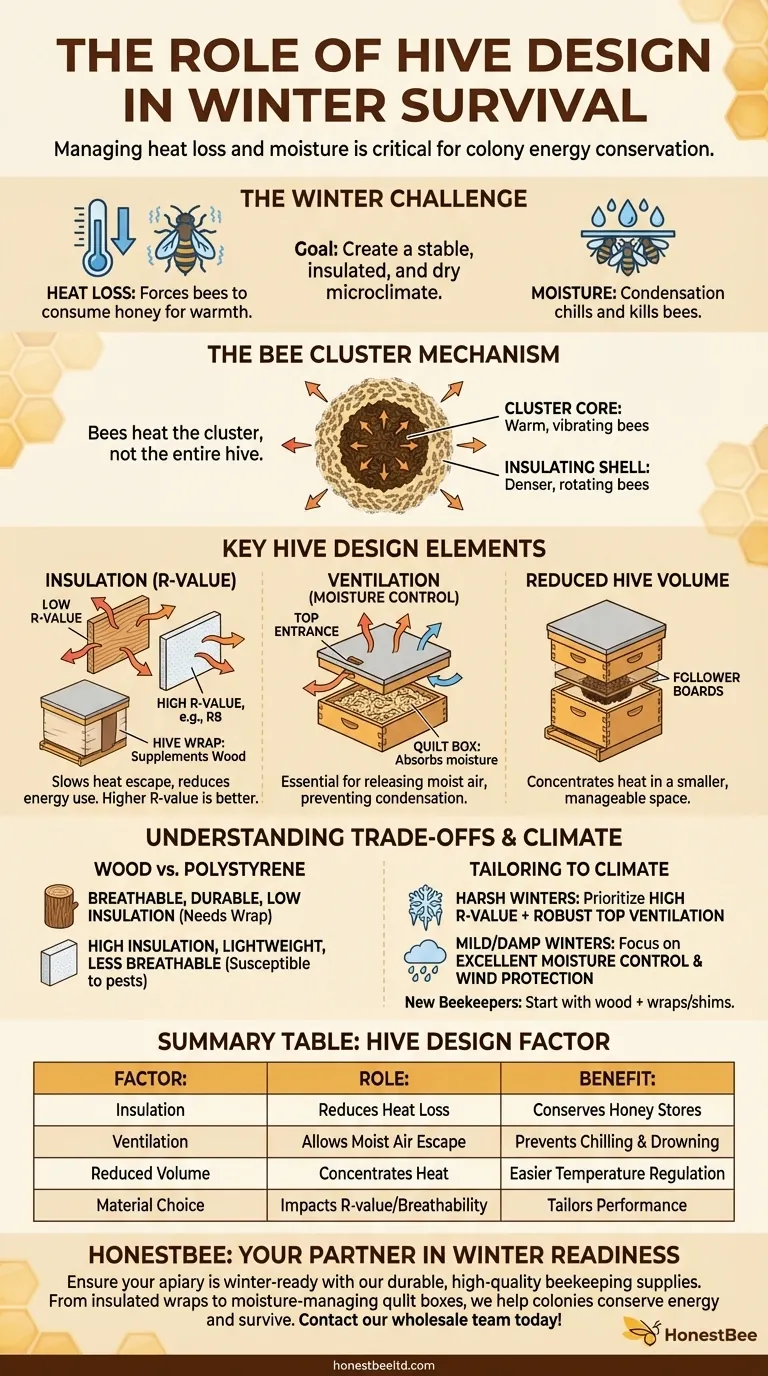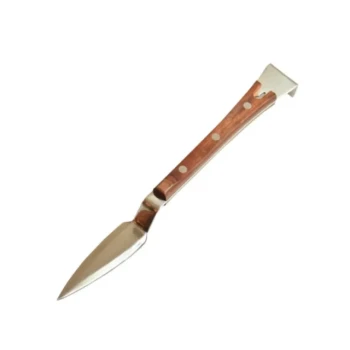The right hive design is a critical factor in winter survival. Its primary role is not to keep the entire hive warm, but to help the bee colony manage its two greatest winter threats: heat loss and moisture. A well-designed or properly modified hive reduces the energy bees must expend to stay warm, conserving their vital food stores and protecting them from deadly condensation.
The ultimate goal of a winter-ready hive is to create a stable, insulated, and dry microclimate around the bee cluster. This minimizes the colony's energy consumption, ensuring they have enough honey reserves to survive until spring.

The Core Principles of Winter Hive Management
To understand hive design, you must first understand how a honeybee colony survives the cold. They do not heat the entire hive interior like a furnace heats a house.
Understanding the Bee Cluster
Honeybees survive by forming a tight ball known as a winter cluster. Bees on the inside of the cluster generate heat by vibrating their wing muscles, while bees on the outside form a dense, insulating shell. The colony constantly rotates, so no single bee freezes on the exterior. The core of this cluster is kept at a stable, warm temperature, while the hive box itself may be only a few degrees warmer than the outside air.
The Two Enemies: Heat Loss and Moisture
A colony's survival depends on managing its energy budget. Heat loss is a direct drain on that budget, forcing the bees to consume more honey to generate warmth. Just as dangerous, however, is moisture. The bees' respiration and the evaporation of honey release a significant amount of warm, moist air. When this air hits a cold inner surface of the hive, it condenses into water, which can drip back down onto the cluster, chilling and killing the bees.
Energy is Everything
Every calorie a bee burns to generate heat comes from its honey stores. An inefficient hive that leaks heat or is too large forces the colony to burn through its winter food supply much faster. A well-designed hive acts as an energy-saving device, ensuring the colony has enough fuel to last until the first spring nectar flow.
Key Hive Design Elements for Winter
Effective winter hive design focuses on insulation to manage heat loss and ventilation to manage moisture.
Insulation: The Primary Defense
Insulation slows the rate at which heat generated by the cluster escapes the hive. This creates a more stable internal temperature and reduces the energy required by the bees.
Materials with a higher R-value provide better insulation. Modern polystyrene hives often have high R-values (like R8 or more), while traditional wooden hives have much lower values. You can supplement a wooden hive's insulation by using external hive wraps, which shield the colony from heat loss and cold winter winds.
Ventilation: The Unsung Hero
While sealing a hive seems intuitive, a completely airtight hive is a death trap. Proper ventilation is essential for allowing moist air to escape before it can condense.
A small upper entrance or a "quilt box" filled with moisture-absorbing material (like wood shavings) placed at the top of the hive allows this warm, humid air to exit safely. This prevents condensation from forming on the inner cover and dripping down on the bees.
Reduced Hive Volume
A smaller space is easier for the colony to manage. For winter, beekeepers often reduce the hive to two boxes or even one, depending on colony size. Placing follower boards inside the hive can also reduce the internal volume, concentrating the cluster and its heat in a smaller, more manageable area.
Understanding the Trade-offs
There is no single "perfect" hive design, and every choice involves a compromise. Understanding these trade-offs is key to making the right decision for your specific environment.
The Risk of Over-Insulating
A common mistake is to add significant insulation without also providing adequate ventilation. This can create a warm, humid environment perfect for trapping moisture. Remember, cold bees can survive, but wet and cold bees will die. Your insulation and ventilation strategies must work together.
Material Choices Matter
Wooden hives are traditional, breathable, and durable. However, they offer minimal insulation on their own and typically require modification with wraps or insulation panels for harsh winters.
Polystyrene hives provide superior insulation and are lightweight, but they are less breathable and can be more susceptible to pest damage or physical wear and tear.
Making the Right Choice for Your Climate
Your local climate dictates your priorities. Tailor your winter hive strategy to the specific challenges your bees will face.
- If your primary focus is surviving harsh, freezing winters: Prioritize high R-value insulation (wraps or polystyrene hives) combined with a robust top-ventilation system to manage moisture.
- If your primary focus is managing mild, damp winters: Concentrate on excellent moisture control and wind protection, as fluctuating temperatures and constant dampness can be just as stressful as deep cold.
- If you are a new beekeeper: Start with a standard wooden hive and learn to supplement it with hive wraps and ventilation shims before investing in specialized, fully-insulated hives.
Ultimately, a well-prepared hive gives your colony the stable, dry environment it needs to do what it does best: survive.
Summary Table:
| Hive Design Factor | Role in Winter Survival | Key Benefit |
|---|---|---|
| Insulation | Reduces heat loss from the bee cluster | Conserves honey stores, lowers energy consumption |
| Ventilation | Allows moist air to escape, preventing condensation | Protects bees from chilling and drowning |
| Reduced Hive Volume | Concentrates cluster heat in a smaller space | Makes temperature regulation easier for the colony |
| Material Choice (e.g., Wood vs. Polystyrene) | Impacts insulation R-value and breathability | Tailors hive performance to specific climate needs |
Ensure your apiary is winter-ready with HONESTBEE's durable beekeeping supplies. We specialize in providing commercial apiaries and distributors with high-quality hive components designed for optimal insulation and ventilation. From insulated hive wraps to moisture-managing quilt boxes, our equipment helps your colonies conserve energy and survive the cold. Let us help you build a hive system that supports bee health year-round. Contact our wholesale team today to discuss your needs!
Visual Guide

Related Products
- Wholesales Dadant Size Wooden Bee Hives for Beekeeping
- Beekeeper Cowboy Hat and Veil for Beekeeping
- Professional Galvanized Hive Strap with Secure Locking Buckle for Beekeeping
- HONESTBEE Premium Italian Style Hive Tool with Hardwood Handle
- Langstroth Bee Hives Bee Keeping Box for Beginners Beekeeping
People Also Ask
- What should beginners consider when purchasing beekeeping equipment? A Guide to Essential Starter Gear
- What are the advantages of wooden bee hives? Superior Bee Health & Beekeeper Flexibility
- What types of products are available for beekeeping needs? Essential Equipment for Apiaries & Distributors
- Why were wooden hives traditionally preferred? For Natural Beekeeping Aligned with Bee Biology
- How often should the area under beehives be inspected and cleaned during the warm season? A Proactive Maintenance Guide



















